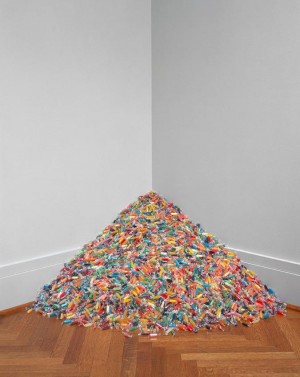You have no items in your cart. Want to get some nice things?
Go shopping
In one of the biggest openings of this year’s Frieze fringe events, Blain|Southern Gallery in Hanover Square presents Candy, a group show of works from Cuban-born Félix González-Torres and quintessential YBA Damien Hirst. Brash and unapologetic, the exhibition title is fitting, as the exhibition is nothing if not a candy-shop for contemporary art enthusiasts.
Initially, it’s González-Torres’s artworks that constitute the more intriguing section of the show; his works are defined by their simple geometric vocabulary – in this exhibition’s cases large but orderly piles of brightly coloured sweets. Most notable for his sculptural works made with readily available commercial materials, González-Torres’ candy pieces force questions of aesthetics, enjoyment and identity. The audience’s perspective on the candy pieces, which are installed in variable dimensions, changes with each showing – not in terms of their metaphysical content but in their physical reality. His AIDS-related death in 1996 left each of the candy installation pieces to be designed and individually set out by gallery staff – an idiosyncrantic installation technique if there ever was one – and each of his three candy designs on display are facets of the same work: his 1992 work Untitled.
Unlike most sculpture you see, these are not installations to be viewed from afar. The candy is there to be taken, to eat, to move, to touch – giving the work a rare vulnerability. The amounts of candy can swell or they can fall; the artwork can even disappear altogether. González-Torres openly spoke of this artistic practice as “the refusal to make a static form [or] monolithic sculpture”, the works making instead a statement of instability and loss. The beauty of colour and the joy of sweet treats are juxtaposed with the fragility of their life cycle. Our place in the universe is invoked by this work – a place both joyous and doomed.
The colours used in candy wrappers are mirrored in Damien Hirst’s paintings. With names like Dippy Dappy Dabby (1993) and Super Happy Happy Dabby (also 1993), an ironic nod may be the first response many form to the works. Joking on the ease of technique, his pieces are simple in form; bright spots of colour in unstable sizes cover the canvas. These works reek of interior design – easy abstract pieces to don any wall – but this is part of their purpose: according to Blain|Southern, these pieces interrogate the long-held prejudice that any work of art that gives a basic, instant form of gratification is automatically insignificant. In Hirst’s case the answer to this must invariably be no. As an unmistakable titan of the international art market, nothing Hirst does is insignificant – his “visual candy”, a phrase coined in reaction to Hirst’s spot paintings, dictates much of the contemporary art marketplace.
Outside of a shared colour palette, the darkness that hides within González-Torres’ works also lies in Hirst’s. Not intended to be sweets, Hirst’s works are brightly coloured pills, abstracted into mere colours. To look at them is to experience a visual high; the exhibition makes explicit the thematic link to mood-enhancing drugs. Through placing them alongside the candy piles of Untitled, this socio-political commentary is extended our to how we reward children and the inevitable comedown of any high.
Sceptics will brand this show a gimmick, a tawdry cover for a lack of physical artistic talent. However, to my perspective, it remains one of the most intriguing and inventive contemporary art exhibitions this year, offering a gratification that is both immediate and enduring.
Candy runs at Blain|Southern until Nov 30. The exhibition is free. See the gallery website for more information.
About Ellen Stone
A freelance artswriter, critic and curator, Ellen also works as a Project Manager for the arts website kidsofdada.com. With a particular interest in contemporary art and art practices, Ellen has wrtten professionally about everything from European cinema to medieval book illustrations. Follow her on Twitter: @eestone1 or visit her blog: ellenelizabethstone.wordpress.com




